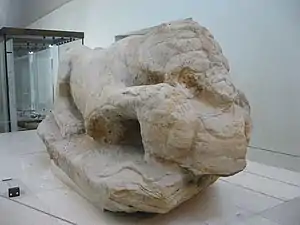Cramond Lioness
The Cramond lioness is a Roman-era sculpture recovered in 1997 from the mouth of the River Almond at Cramond in Edinburgh, Scotland. The sculpture, which turned out to be one of the most important Roman finds in Scotland for decades, was discovered by ferryman Robert Graham.[1]

It depicts a bound male prisoner being killed by a lioness. The upper torso and head of the prisoner are shown, with the giant lioness behind him, sinking her teeth into his skull.
The work is interpreted as a Roman sculpture imported to Scotland to serve as part of the tomb of a Roman military commander or dignitary, and connected to the nearby Cramond Roman Fort. The location of such a tomb, and how the sculpture reached its location in the river are unknown.[2]
The sculpture is housed at the Museum of Scotland in Edinburgh. In 2003, plans were unveiled for the lioness to be housed in a new archaeological centre at the Roman Fort in Cramond,[3] although this proposal was still at the initial planning stage in 2008.[4]
References
- "Cramond Lioness". National Museum of Scotland.
- "Cramond Ferry". CANMORE. Royal Commission on the Ancient and Historical Monuments of Scotland.
- "Lion to take pride of place at Roman ruins". The Scotsman. 21 August 2003. Retrieved 9 December 2009.
- "Roman fort will be centrepiece of new tourist attraction". The Scotsman. 29 August 2008. Archived from the original on 23 November 2008. Retrieved 9 December 2009.
External links
- Cramond Lioness, National Museum of Scotland
- Cramond Roman Fort, AOC Archaeology
- Images of the front (showing prisoner clearly), and right side of the sculpture, DK Images